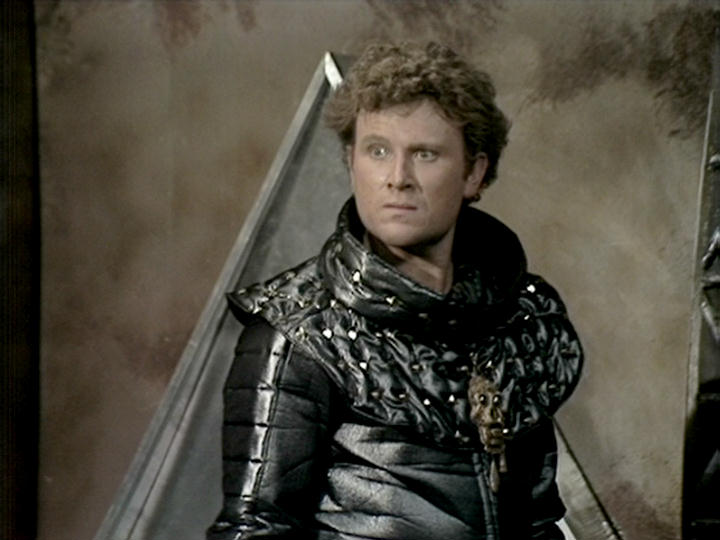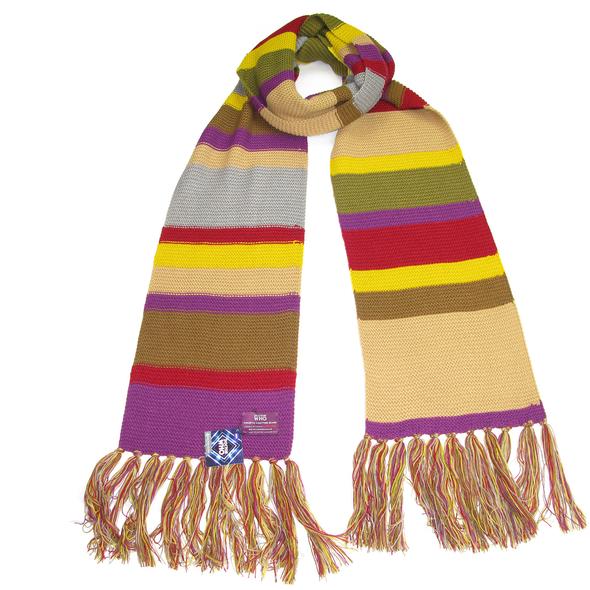Many Doctor Who fans are also fans of Blake’s 7, a cult BBC series from the late 1970s. Do they belong in the same universe, and are they two sides of the same coin?

Certainly, one key factor that unites both Doctor Who and Blake’s 7 is the writer Terry Nation. Indeed, Nation created Blake’s 7 in 1977, and even though he didn’t create Doctor Who, he was arguably instrumental in its long-term success, penning the early story ‘The Daleks‘ which introduced the series’ most enduring villain. In fact, one could argue that Doctor Who might not have lasted had it not been for the mammoth success of the metal mutants from Skaro.
And with Blake’s 7, viewers have a villain that’s not too dissimilar from the dreaded Daleks. This time, though, it’s the faceless Federation – a totalitarian regime that controls the galaxy through lies, oppression and drugs. Its leaders may not be encased in polycarbide, but they are the same at heart – ruthless beings who think nothing of killing to achieve their ends. Indeed, the very first episode of the series – ‘The Way Back’ – sees the Federation massacre a group of unarmed civilians because they dared to go outside. Cosy tea-time viewing this isn’t.

There is hope, though. Doctor Who may have the TARDIS, but the eponymous Blake has the Liberator – a super-powered, alien spacecraft with which he and his fellow rebels can fight the forces of evil. It’s a bit like having his own star destroyer, complete with a teleporter and a talking computer called Zen.
And what’s interesting about Blake’s 7 is that it was being produced at the same time as Doctor Who, so many of the writers, directors and designers worked across both series, often simultaneously. David Maloney, for example, became the series’ first producer, taking the role after overseeing the classic Tom Baker story ‘The Talons of Weng-Chiang,’ whose composer was Dudley Simpson – the man who would write the iconic Blake’s 7 theme tune, and score almost every episode.
Indeed, so closely linked were the two shows that a number of crossover scenarios were considered. For example, in the Blake’s 7 episode ‘Star One,’ the galaxy is under attack from a race of aliens from Andromeda. Initially, this was planned to be the Daleks – a move that would have placed the two shows very firmly in the same universe. In fact, it would even have opened up the possibility of Blake and his crew meeting the Doctor himself, which is surely the crossover we all need. (Please make it, Big Finish.)
And whilst this may sound a bit far-fetched, it wasn’t the only crossover scenario that was considered for Blake’s 7. The actor Gareth Thomas (who played Blake) had become friendly with Tom Baker (who, incidentally, had also auditioned for Blake.) The pair suggested that there could be a random crossover scene in either Blake’s 7 or Doctor Who where the characters would pass each other in a corridor, greet each other with a “Morning, Doctor!” / “Morning, Roj!” and then carry on as normal.
This, however, was not an idea the BBC liked, and sadly the plan never came to fruition. Similarly, the appearance of the Daleks in ‘Star One’ was quickly abandoned, with Blake and his crew instead fighting a mysterious race of shapeshifters that went (mostly) unseen – in their original form, at least.
So whilst Blake’s 7 never contained any obvious connections to Doctor Who, the fact that both series shared many of the same writers meant that some of their episodes could belong to either franchise, albeit with a few tweaks.

The writer Robert Holmes is a good example of this. He penned some of the most popular Doctor Who serials of all time, such as the aforementioned ‘Talons of Weng-Chiang’ and 1984’s ‘The Caves of Androzani.’ And one of Holmes’ strengths was his use of double acts – pairing characters up for dramatic and comic effect. This is particularly obvious in ‘Weng-Chiang’ with Henry Gordon Jago and Professor Litefoot, whose partnership proved so successful that the BBC considered giving them their own spin-off series (a plan that Big Finish would later fulfil.)
And Holmes brought this writing style to Blake’s 7, showing a particular fondness for the characters of Avon and Vila. He paired them up in the majority of his Blake’s 7 episodes, most notably ‘Killer,’ ‘Gambit’ and ‘Orbit,’ which have gone on to become fan favourites. And if you’re unfamiliar with Avon and Vila, think Dirty Harry and the comedian Tony Hancock. In short – if you’ve ever enjoyed one of Robert Holmes’ Doctor Who episodes, you’re almost certain to enjoy his Blake’s 7 scripts.

Then we have Chris Boucher, who was the script editor of Blake’s 7 across all four seasons. Anyone who’s ever seen his Tom Baker story ‘The Robots of Death’ will be similarly entertained by the Blake’s 7 episode ‘Headhunter,’ which he oversaw. Indeed, this was one of the many occasions in which Blake’s 7 drifted from gritty realism to sci-fi horror, with other examples being ‘Sarcophagus,’ ‘Rescue’ and ‘Sand.’ Again, many of these episodes could be repurposed as gripping Doctor Whos, particularly ‘Sand,’ which is all about flesh-eating dust.
And finally, we cannot overlook the plethora of actors who have starred in both Blake’s 7 and Doctor Who. One of the most notable examples is Colin Baker (the Sixth Doctor) who appeared in the 1980 story ‘City at the Edge of the World’ in which he gave a fantastic, scenery-eating performance as the unhinged Bayban the Butcher (“call me Babe.”) The character certainly gave Paul Darrow (Avon) a run for his money in the set-eating stakes – although this was something Darrow later overcame when he found himself acting once again opposite Baker in the Sixth Doctor story ‘Timelash.’ Determined not to be overshadowed, he decided to play the villainous Tekker like Laurence Olivier’s Richard III – complete with long hair and maniacal grin.

And whilst we’re still waiting for a Tekker spin-off from Big Finish, the popularity of Colin Baker’s Bayban has endured – so much so that Big Finish has just announced an official Bayban the Butcher spin-off, with Baker reprising his role as the psychotic “Babe.” This is remarkable considering that ‘City at the Edge of the World’ has (to my knowledge) never been repeated, and is now over forty years old. It promises to be excellent.
Have you ever watched Blake’s 7? Do you believe it could exist in the same universe as Doctor Who? And if you’ve never seen it, are you tempted to give it a go? Let me know in the comments.

Doctor Who scarf – order now from the Lovarzi shop!
Shop on Amazon
Latest posts…
- Doctor Who stories: Looking back at the Western adventures
- The top 5 silliest Doctor Who rumours
- The Reality War: The story behind the Fifteenth Doctor’s regeneration
- What would a Doctor Who missing episodes drama be like?
- Wish World: Another alternate reality story for the Doctor


Probably the most obvious Blake’s7/Doctor Who crossover is “Kaldor City” a 6-part audio series produced by Magic Bullet Productions.. The series takes place in the world of Chris Boucher’s Doctor Who serial “The Robots of Death”, and features characters from that story, such as Uvanov, still brilliantly played by Russell Hunter. It also contains elements from Boucher’s other serial “Image of the Fendahl”. It stars Paul Darrow as assassin and bodyguard Kaston Iago, a character who could easily be a post-Gauda Prime Kerr Avon in disguise (in fact, in “Metafiction”, a hilarious specially-produced mini episode, he comes right out and tells his interrogator all the events he was part of in Blake’s 7!) The series also makes use of the character of Carnell, the psychostrategist from the Blake’s 7 episode “Weapon” (again played by Scott Fredericks) so even if you consider the Kerr Avon/Kaston Iago link tenuous (the aforementioned “Metafiction“ was written as a bit of a gag episode), the series still decidedly contains elements from both Doctor Who and Blake’s 7.
Interestingly, Chris Boucher’s Doctor Who novel “Corpse Marker” (which acts as a kind of pilot for Kaldor City) also includes the character of Carnell, so it can be said to exist in both universes also.
“For example, in the Blake’s 7 episode ‘Star One,’ the galaxy is under attack from a race of aliens from Andromeda. Initially, this was planned to be the Daleks”
This isn’t exactly an urban myth, but it really is one of the most exaggerated claims made about Blake’s 7. It seems to be an attempt by B7 fans to draw attention of young fans of the revived Dr Who, by trying to overstate the overlap between the two series. In reality, the BBC was very wary of letting the two shows get intertwined at all, and often went out of its way to keep key personnel from each show away from the other.
The idea that the Daleks were going to appear in Star One is, as I say, massively exaggerated. All that really happened was a vague suggestion at a pre-production planning meeting for Blake’s 7 second season, between the three-man ‘brain-trust’ of David Maloney as Producer, Chris Boucher as script editor, and Terry Nation as series originator. During the meeting, they established the approximate plot structure for the season ahead, built around the search for the Federation’s “central control center”, more or less as it eventually happened on-screen. The big irony intended was that, having spent years trying to destroy the Federation, the Liberator crew do find Control, but just as they are about to blow it up, an alien race arrives from another Galaxy and is poised to annihilate the human race, and so Liberator instead finds itself having to defend the Federation.
Satisfied with that plot structure, the discussion then turned to who the aliens should be, and Nation spoke up with the suggestion they could use the Daleks. Both Maloney and Boucher immediately and very firmly said, “NO! Don’t even go there!”
And that was it.
That’s the top and bottom of it, just a vague suggestion off the top of the head, shut down in seconds, and no one ever brought it up again. It was certainly never ‘planned’ to be part of the series.
The BBC would almost certainly have ruled it out even if Maloney and Boucher had given the thumbs-up. Part of the problem with it was that the implications of making B7 and Dr Who part of the same universe were actually very daunting. You get a Liberator vs the Daleks story in Blake’s 7, so you’ll soon have fans of either series crying out for an Avon vs the Master Blake’s 7 Christmas Special, a Sontarans war with the Terran Federation serial in Dr Who, a Servalan vs the Doctor showdown, a Travis-being-revived-as-a-Cyberman story etc. The legal difficulties alone in trying to arrange such crossovers would have been an absolute minefield, given many of the monsters in Who were not intellectual property of the BBC, but of the individual writers who created them.
And the second problem was, truth to tell, a crossover for the sake of it would probably be quite a forced and cheesy story not worth the legal headaches. A bit like most of the multi-Doctor stories that have been made for major anniversaries of Dr Who haven’t been much kop.
Bottom line, “the Daleks in Blake’s 7” was never on the cards, and it’s somewhat misleading to imply that it ever really was. While it’s fun to think about, it’s probably for the best that the idea was shot down as soon as it was suggested. Best leave that one to the imagination, as the reality would have disappointed, and created so many problems for both series.